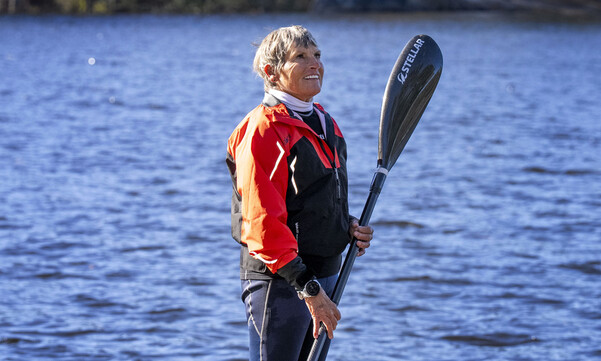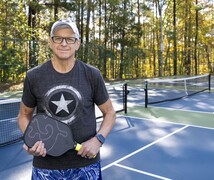After arthroscopic surgery and physical therapy for her hip injury, Sam Hanebeck was back in the saddle again. This time, however, she could ride her beloved horse pain free.
When a career opportunity led 34-year-old Sam Hanebeck from England to Cary, NC, in 2004, she brought her horse along for the ride. Horses have always been Hanebeck’s passion.” “It’s an honor that they allow us to ride them,” she said. “When I’m on a horse, I’m at peace and I forget about everything else.”
In 2012, however, riding became a source of hip pain Hanebeck couldn’t ignore. “I could ride, but the day after, the pain in my hip would be dull. Eventually, the pain progressed to a level that was unbearable,” she said. “I couldn’t sleep and I wasn’t able to get out of a chair. Day-to-day activities were painful.”
After a series of misdiagnoses, Hanebeck turned to Richard Mather, MD, a Duke orthopaedic surgeon who specializes in sports medicine and hip preservation procedures. At her first appointment, Mather ordered multiple X-rays of her hip to help him determine the source of the pain. “When he told me what it was, I cried," Hanebeck said. "I thought, ‘I’m not going crazy.’”
“Hip arthroscopy has evolved rapidly over the last few years," said Mather. "We can now treat FAI and other hip problems very successfully.”
Labral Tear was the Cause of Pain
Mather diagnosed Hanebeck with combined femoroacetabular impingement (FAI), a structural abnormality of the hip joint that alters its biomechanics and often leads to a labral tear and cartilage damage. He performed arthroscopic surgery, a minimally invasive procedure commonly used to repair knee and shoulder joint injuries. “Hip arthroscopy has evolved rapidly over the last few years," said Mather. "We can now treat FAI and other hip problems very successfully.”
Hanebeck felt confident surgery was the right choice. “Dr. Mather gave me options for treatment,” Hanebeck said. “I trusted his skills as a surgeon just based on his manner and care he demonstrated. He totally put me at ease.”
Hanebeck’s surgery was lengthy due to the extent of her injury, but the result was instant pain relief. “This was a drastic improvement,” she said. “Dr. Mather came to see me after surgery and already the pain was radically reduced.”
PT Returned Strength, Balance, Mobility
According to Mather, rapid pain relief is common following this type of surgery, however the pain can return without appropriate physical therapy. Hanebeck worked closely with Duke physical therapist Chris Fiander to build back her strength, balance and mobility. “I was terrified,” Hanebeck said. “I had to learn to walk again.”
Fiander's kind, caring nature put her instantly at ease. “He’s there to pick you up when you need it and encourage you to reach your goal," Hanebeck said. I fully trusted him.”
“With Sam, not pushing too aggressively was the early challenge,” said Fiander. “She would’ve liked to do more, but we had to monitor her activity level so that she would have a good, smooth recovery.”
A typical physical therapy regimen for this type of procedure would include approximately 16 weeks of regular sessions that slowly build in intensity over time to incorporate strength, mobility, and weight-bearing exercises. “We base the therapy on each patient’s goals and what they want to get back to,” said Fiander.
Faster Than Average Recovery
Hanebeck wanted nothing more than to get back on her horse. “I told Chris I want to walk, trot, canter, and jump again. Tell me what I need to do,” she said. “He researched the positioning of a rider’s body in the saddle, along with the movement of both horse and rider, so that he could tailor my exercises.”
The hard part was following through. “You have to do the work,” said Hanebeck. “It gets tough, but it’s worth it.”
“When a patient is actively involved in recovery, you get the best outcomes, and Sam was involved from the start,” said Fiander.
Her recovery was faster than average. Ten weeks later, Hanebeck sat on her horse for the first time. Four months after surgery, she was back to full speed. “I am walking, trotting, and cantering my horse, and I’m totally pain free … it truly is an amazing feeling.”





